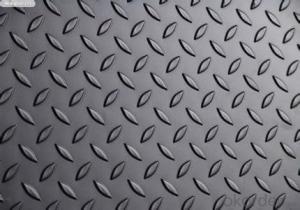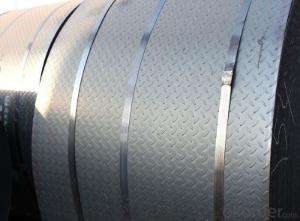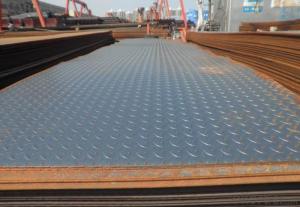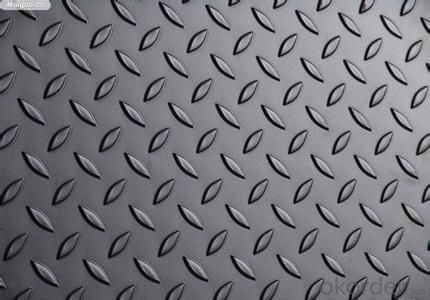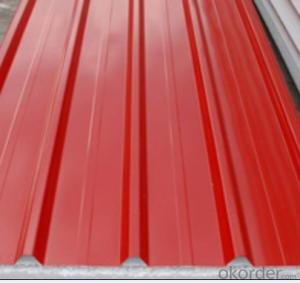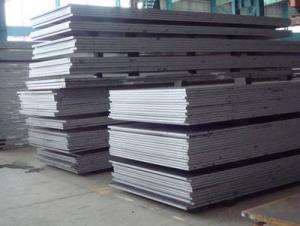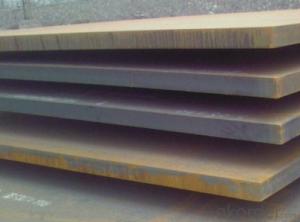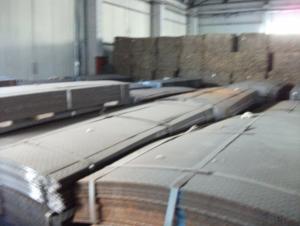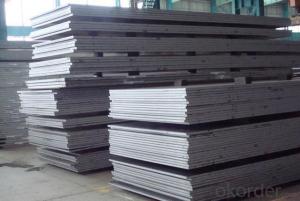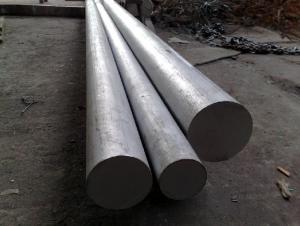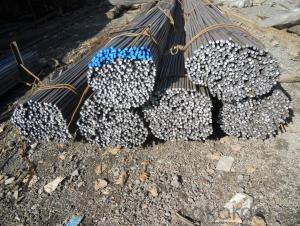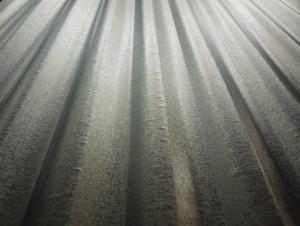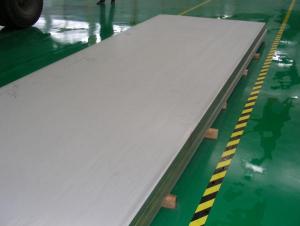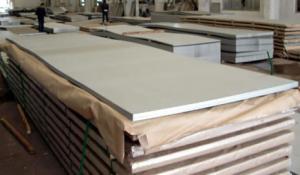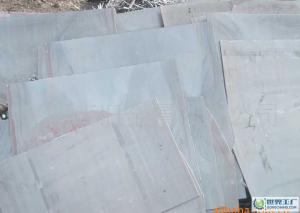Hot rolling steel checkered plate
- Loading Port:
- China Main Port
- Payment Terms:
- TT OR LC
- Min Order Qty:
- -
- Supply Capability:
- -
OKorder Service Pledge
OKorder Financial Service
You Might Also Like
The pattern shape
A tread surface plate is called a pattern plate, English Name: Diamond plate. The pattern of lentil shaped, diamond, round bean
Shape oblate shape, mixed, the market to the most common lentil shaped.
The specific application of
Pattern plate appearance, can slip, enhanced performance, and many other advantages,such as saving steel in transportation, construction, decoration, equipment around the floor,machinery, shipbuilding and other fields has been widely applied. In general, the use of side of the mechanics pattern plate performance, mechanical performance requirements is not high, so the pattern plate quality mainly flowering rate, as the pattern of pattern height, height difference. At present the common thickness on the market ranging from 2.0-8mm, the width of common 12501500mm two.
The relevant standards
In accordance with the provisions of national standards GB/T 3277 pattern plate, patternheight should be greater than or equal to the thickness of the 20% substrate.
Theoretical calculation of weight
Pattern plate, according to the material (aluminum alloy, stainless steel, ordinary steel etc.)different patterns of different shapes and different weight per square meter adjustment.
Class B common carbon steel rolling, the provisions of chemical composition meet the GB700"ordinary carbon structural steel technical conditions".
Pattern plate of high no less than 0.2 times the thickness of the substrate;
Checkered steel plate according to the weight of the actual weight of delivery or theory;
Mark example: made of Q235-A, size 4*1000*4000mm.
Peaberry pattern plate, mark it as: round bean plate Q235-A-4*1000*4000-GB/T 3277-91
Diamond pattern plate, mark it as: diamond pattern plate B 3-4*1000*4000-GB 3277-82
Steel with hot-rolled state of delivery;
Checkered steel plate surface without bubble, scar, crack, folding and inclusion, plate without delamination.
The surface quality is divided into two levels:
The general accuracy: steel surface with a thin layer of oxide scale and rust allowed, due to other local defects on the surface of oxide scale formed off rough and height or depthexceeds the allowable deviation of the ancient.
Burr height is not obvious and not more than the individual trace lines high allows patterns.The largest area of a single defect pattern with the square of the length of not more than.
High precision: steel surface with a thin layer of oxide scale, allowing the rust and the height or depth of no more than other local defects of half the thickness tolerance.
Pattern intact, a height of not more than half of the tolerance of thickness of the local slightburr allowed patterns.
- Q: What are the safety considerations when handling steel sheets?
- When handling steel sheets, there are several safety considerations to keep in mind. Firstly, it is important to wear appropriate personal protective equipment (PPE) such as gloves, safety glasses, and steel-toed boots to protect against potential injuries. Secondly, steel sheets can be heavy and cumbersome, so it is crucial to use proper lifting techniques and equipment to avoid strains or muscle injuries. Additionally, sharp edges or corners on steel sheets can pose a risk of cuts or punctures, so caution should be exercised when handling them. Lastly, steel sheets can be slippery when wet or oily, so it is essential to maintain a clean and dry working area to prevent slips and falls. Overall, awareness, caution, and adherence to safety protocols are key when handling steel sheets to ensure the well-being of individuals involved.
- Q: What are the different packaging options for steel sheets?
- Some common packaging options for steel sheets include wooden crates, cardboard boxes, and metal skids. These packaging options provide protection during transportation and storage, ensuring that the steel sheets remain in good condition.
- Q: What is the average wind load capacity of steel sheets?
- The average wind load capacity of steel sheets can vary depending on various factors such as the thickness of the sheet, the type of steel used, and the specific design and installation of the structure. However, steel sheets are known for their high strength and durability, making them capable of withstanding significant wind loads. Typically, steel sheets used for roofing or cladding applications are designed to meet specific wind load requirements based on regional building codes and standards. These standards take into account factors such as the geographical location, building height, exposure category, and wind speed. To determine the wind load capacity of steel sheets, engineers and architects use calculations and simulations to analyze the forces exerted by the wind on the structure. They consider factors such as wind pressure, building orientation, surface area, and the shape and profile of the steel sheets. In summary, the average wind load capacity of steel sheets cannot be generalized as it varies based on several factors. It is crucial to consult with a structural engineer or building professional to determine the appropriate wind load capacity requirements for a specific steel sheet application.
- Q: Do steel sheets require any special storage or handling?
- Yes, steel sheets require special storage and handling to ensure their integrity and avoid any damage. They should be stored in a clean, dry, and well-ventilated area to prevent corrosion. Additionally, they should be stacked in a way that prevents distortion or bending. When handling steel sheets, it is important to use proper lifting equipment and techniques to prevent accidents and maintain the quality of the sheets.
- Q: Can steel sheets be used for automotive chassis?
- Yes, steel sheets can be used for automotive chassis. Steel is a commonly used material in the automotive industry due to its strength, durability, and cost-effectiveness. Steel sheets provide the necessary structural integrity and support required for automotive chassis, making them a suitable choice for this purpose.
- Q: Are steel sheets suitable for automotive chassis?
- Yes, steel sheets are suitable for automotive chassis. Steel is a commonly used material in the automotive industry due to its strength, durability, and cost-effectiveness. Steel sheets provide the required structural integrity and support for the chassis, ensuring the safety of the vehicle and its occupants.
- Q: What are the different types of steel sheet finishes for decorative purposes?
- For decorative purposes, one can find several varieties of steel sheet finishes that are commonly utilized. These finishes are applied to the steel sheet's surface with the intention of enhancing its appearance and achieving a desired aesthetic effect. Some of the most favored finishes for decorative purposes are as follows: 1. Brushed Finish: Achieved by brushing the steel sheet's surface with a fine abrasive material, usually in a straight line pattern, this finish imparts a smooth and satin-like appearance. It is widely used in architectural and interior design applications. 2. Mirror Finish: Also known as a polished finish, this type creates a highly reflective surface that resembles a mirror. The steel sheet is mechanically polished to achieve this finish, and it is commonly seen in decorative applications such as furniture, lighting fixtures, and signage. 3. Patterned Finish: This finish involves embossing or etching a pattern onto the steel sheet's surface. It can be achieved through various techniques like stamping, laser engraving, or chemical etching. Patterned finishes provide a decorative and textured appearance and are often used in applications like elevator panels, wall cladding, and decorative screens. 4. Colored Finish: To add vibrancy and enhance visual appeal, steel sheets can be coated with a colored finish. Processes such as powder coating are employed, where a dry powder is applied to the steel sheet and then cured to create a durable, colored finish. Colored finishes are commonly used in architectural applications like building facades and signage. 5. Antique Finish: This particular finish is designed to give the steel sheet an aged or weathered look, resembling antique metal. Various techniques such as chemical treatments, patinas, or distressing can be employed to achieve this appearance. Antique finishes are often utilized in decorative applications to create a rustic or vintage aesthetic. These are just a few examples of the diverse range of steel sheet finishes available for decorative purposes. Each finish provides a distinct appearance and can be customized to suit specific design preferences. The choice of finish relies on factors such as the desired look, application, and required level of durability for the project.
- Q: How do steel sheets perform in fire-rated applications?
- Due to their high melting point and excellent structural integrity, steel sheets are highly effective in fire-rated applications. When exposed to fire, steel sheets retain their strength and stability, making them a dependable choice for fire-resistant construction. Furthermore, steel sheets do not contribute to the spread of fire or the release of harmful fumes, thereby enhancing the safety of occupants during a fire incident. In addition, steel sheets offer exceptional thermal insulation, preventing the transfer of heat from the fire to other parts of the building. This characteristic enables the containment of fires and minimizes the resulting damage. In conclusion, utilizing steel sheets in fire-rated applications offers a sturdy and efficient solution for fire protection in buildings.
- Q: Are steel sheets resistant to bullet penetration?
- Yes, steel sheets are generally resistant to bullet penetration due to their high hardness and strength. However, the degree of resistance may vary depending on the thickness and quality of the steel.
- Q: The differences and uses of cold rolling and hot rolling
- Cold rolled forming steel allows partial buckling of the cross section, thus taking full advantage of the post buckling capacity of the member, while the hot-rolled section does not allow partial buckling of the cross section.
Send your message to us
Hot rolling steel checkered plate
- Loading Port:
- China Main Port
- Payment Terms:
- TT OR LC
- Min Order Qty:
- -
- Supply Capability:
- -
OKorder Service Pledge
OKorder Financial Service
Similar products
Hot products
Hot Searches
Related keywords
